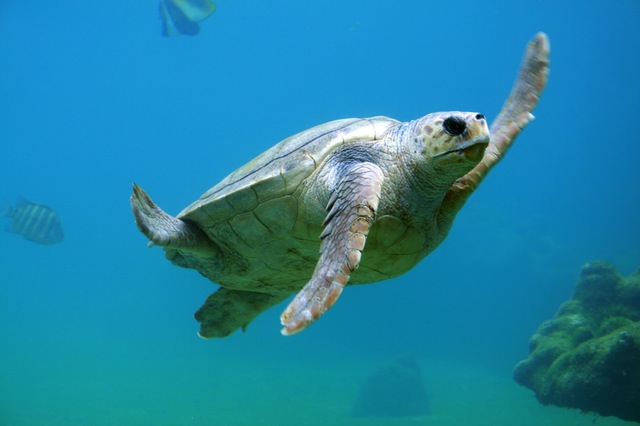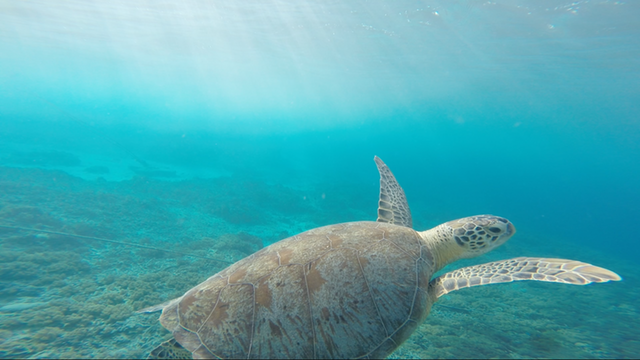Hawaiian green sea turtles have been protected under the endangered species act since 1976.
Until then, you could actually go to Waikiki and order a turtle meat dish from quite a few restaurants, and local residents were still allowed to harvest turtles and eat them. Turtle meat was consumed and still is consumed in many places of the world, perhaps one of the contributing reasons for their decline word wide.
Here in Hawaii, they had a very successful recovery after they were added to the endangered species list and now their population is soaring.
Today we want to talk about how to interact with these beautiful creatures when they come to our popular beaches to REST, yes I said REST not NEST.
The NESTING place for Hawaiian green sea turtles is in the North Western Hawaiian islands.
These Islands are also a part of our chain but they are about 800 miles north west from our main islands. 99.9% of all green sea turtles you see on our beaches and in our oceans go back to those islands to lay their eggs once a year after reaching maturity ( 20 years old )
When you see a turtle in the main Hawaiian islands and they are laying on the beach they are simply RESTING. When turtles come to the beach to lay their eggs they are hard at work, they don’t rest, they don’t sleep. They dig their hole for hours, lay the eggs and return back to the sea!
Why do turtles come to our beaches to rest?
Good question… simply because they enjoy the beach, the sun and they feel no THREAT from the humans near by. It has been more than 30 years since they were hunted here and none of this turtles have experienced or seen humans killing their species. They also love to rest on our beaches when the surf is big. Imagine having to come up for air every 20 minutes and taking a 20 foot wave on the head… uhmmmm. Maybe turtles are smarter than we think.
~Ok let’s get to the important stuff, how to behave and enjoy the turtles with out bothering them.
- If you see a turtle on the beach sleeping/resting please stay at least 12 feet from them.
Sometimes there will be no signs near the turtles but you can still be conscious and stay 8 to 12 feet away. If you have a zoom lens, then really, how close do you need to get?
- PLEASE don’t go for the shot sitting right next to the turtle!
The WORST thing you can do for the turtles, would be to sit RIGHT NEXT to them and take a picture, then share it on social media. You are inviting everyone to do the same and that will eventually disturb a LOT of turtles, not only in Hawaii but in other places where they could need more help than here. Did I mention the 500 dollar fine? Touching a turtle and disturbing a turtle can give you a hefty fine. DLNR officers are looking from cliffs or behind trees. Anyone with a camera can take a picture of YOU disturbing a turtle and share it with the DLNR so be careful.

- If there is a turtle coming from the ocean to rest on the beach, please CLEAR THE PATHWAY.
If you stand in front of that turtle, waiting for it to come to the beach, chances are she/he will not come up and the reason is very simple… you are standing on it’s way so please move up and watch from a distance until the turtle finds his/her spot and closes its eyes to sleep.
- If you have a dog, please keep it on a leash and don’t let it sniff or disturb the resting turtles.
- If you have kids, please teach them right and don’t let them touch the turtles, hit the turtles, step on them, sit on them, throw sand or water at them. We understand that pictures of kids sitting right next to turtles are super cute and many times this is NOT truly DISTURBING the turtles but its a horrible example. Promoting this will only make it harder for people like us here at Ocean Defender who are out there on our local beaches educating our residents and visitors about proper behavior with marine creatures.
- It would be courteous of people if they would chose to play, run, get ready to surf or swim at good distance from the resting turtles. Some times this is hard, specially when the tides are high since there is less sandy area on the beach.
This are a few simple rules we encourage you to follow. It’s not impossible to coexist, we just need to do our best.
We would like to end this blog with this though…
It is estimated that in 50 years the ocean water levels will have risen considerably in the Pacific and many atolls and small islands will disappear from our maps. The nesting habitat for our Hawaiian green sea turtles is also at risk. Could it be possible that our green sea turtles are getting ready for this event and they are starting to take over the beaches of our main islands, perhaps preparing us for our future of a more intricate coexistence?
Whatever the reasons are for their coming in high numbers to our beaches on the main Hawaiian islands, we should welcome them and embrace their presence. This is no reason to want to eat them.
We don’t really know what their future holds.
Aloha
~Oriana

